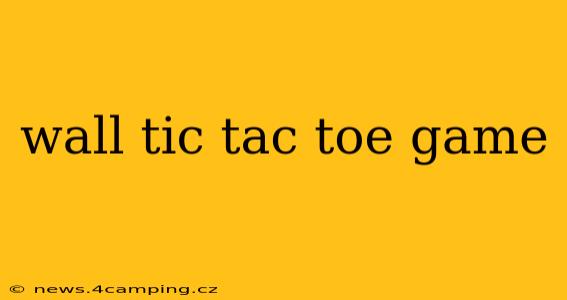Tic-tac-toe, a seemingly simple game, transcends age and cultural boundaries. But what happens when you scale this classic up? Giant wall tic-tac-toe games offer a unique blend of strategy, creativity, and outdoor fun. This guide dives into everything you need to know about creating and playing this larger-than-life version of the beloved game.
What is Wall Tic-Tac-Toe?
Wall tic-tac-toe is a modified version of the traditional game played on a much larger scale, typically on a wall or other large vertical surface. Instead of using a small paper grid, players utilize larger spaces, often marked with paint, tape, or even chalk. The increased size and visual impact make it an ideal game for outdoor events, parties, or even classroom activities. The fundamental rules remain the same: the first player to get three of their marks (X or O) in a row—horizontally, vertically, or diagonally—wins.
How to Create a Giant Tic-Tac-Toe Game
The beauty of wall tic-tac-toe lies in its adaptability. You can customize it to fit your space and resources. Here are some popular methods:
1. Paint: For a permanent solution, consider painting the grid directly onto a suitable wall or fence. Use durable exterior paint to withstand the elements.
2. Tape: Masking tape offers a temporary yet highly visible solution. Use wide tape for better visibility and clear demarcation of the squares.
3. Chalk: Ideal for temporary games on suitable surfaces like asphalt or concrete, chalk allows for easy removal and redrawing.
4. Other Materials: Get creative! Use rope, large tiles, or even repurposed materials to mark the grid.
What size should my wall tic-tac-toe board be?
The optimal size depends entirely on your playing area and the age of the participants. Consider these factors:
- Player Age and Size: Younger children might need larger squares for easier marking and visibility.
- Available Space: Ensure the grid fits comfortably within your chosen location, leaving enough room around it for players to move.
- Markings: Choose a size that allows for clear and easy-to-see markings.
What materials do I need to play?
The materials required depend on your chosen grid creation method. However, you'll generally need:
- Measuring tools: A tape measure or ruler is essential for creating accurate squares.
- Marking materials: Paint, tape, chalk, or other chosen materials.
- Large markers: Use large markers, paintbrushes, or even sponges for making X's and O's. Alternatively, consider using large, easily removable stickers or even hanging objects.
How many players can play wall tic-tac-toe?
While the traditional game is for two players, the larger format of wall tic-tac-toe opens up possibilities for variations. You could have teams of two or more players, or even adapt the rules to accommodate more players in a larger grid (e.g., a 4x4 or 5x5 grid).
What are some variations of wall tic-tac-toe?
Don't limit yourself to the standard rules! Here are some fun variations:
- Larger Grids: Experiment with larger grids (e.g., 4x4 or 5x5) for more complex gameplay.
- Team Play: Divide players into teams and have them collaborate to win.
- Different Markings: Use unique symbols instead of X's and O's.
Conclusion
Wall tic-tac-toe offers a refreshing twist on a classic game. Its adaptability allows you to customize the experience to your space, resources, and players. By incorporating creativity and some simple planning, you can create a memorable and engaging game for all ages. So gather your friends, family, or classmates and get ready to conquer the walls!
